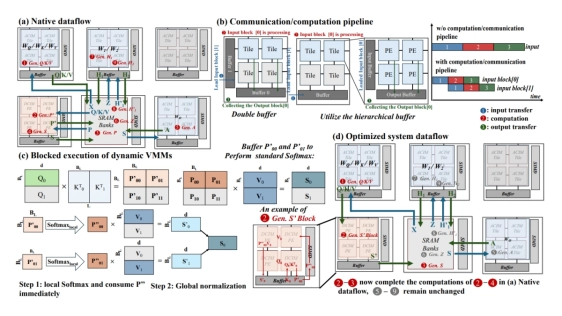Hemlet: A Heterogeneous Compute-in-Memory Chiplet Architecture for Vision Transformers with Group-Level Parallelism
By Cong Wang, Zexin Fu, Jiayi Huang, and Shanshi Huang
The Hong Kong University of Science and Technology (Guangzhou)

Abstract
 Vision Transformers (ViTs) have established new performance benchmarks in vision tasks such as image recognition and object detection. However, these advancements come with significant demands for memory and computational resources, presenting challenges for hardware deployment. Heterogeneous compute-in-memory (CIM) accelerators have emerged as a promising solution for enabling energy-efficient deployment of ViTs. Despite this potential, monolithic CIM-based designs face scalability issues due to the size limitations of a single chip. To address this challenge, emerging chiplet-based techniques offer a more scalable alternative. However, chiplet designs come with their own costs, as they introduce more expensive communication through network-on-package (NoP) compared to network-onchip (NoC), which can hinder improvements in throughput.
Vision Transformers (ViTs) have established new performance benchmarks in vision tasks such as image recognition and object detection. However, these advancements come with significant demands for memory and computational resources, presenting challenges for hardware deployment. Heterogeneous compute-in-memory (CIM) accelerators have emerged as a promising solution for enabling energy-efficient deployment of ViTs. Despite this potential, monolithic CIM-based designs face scalability issues due to the size limitations of a single chip. To address this challenge, emerging chiplet-based techniques offer a more scalable alternative. However, chiplet designs come with their own costs, as they introduce more expensive communication through network-on-package (NoP) compared to network-onchip (NoC), which can hinder improvements in throughput.
This work introduces Hemlet—a heterogeneous CIM chiplet system designed to accelerate ViT. Hemlet facilitates flexible resource scaling through the integration of heterogeneous analog CIM (ACIM), digital CIM (DCIM), and Intermediate Data Process (IDP) chiplets. To improve throughput while reducing communication overhead, it employs a group-level parallelism (GLP) mapping strategy and system-level dataflow optimization, achieving speedups ranging from 1.44× to 4.07× across various hardware configurations within the chiplet system. Our evaluation results demonstrate that Hemlet can achieve a throughput of 8.68 TOPS with an energy efficiency of 3.86 TOPS/W.
Index Terms—Compute-in-memory, Chiplet, Heterogeneous Computing, Mapping
To read the full article, click here
Related Chiplet
- Interconnect Chiplet
- 12nm EURYTION RFK1 - UCIe SP based Ka-Ku Band Chiplet Transceiver
- Bridglets
- Automotive AI Accelerator
- Direct Chiplet Interface
Related Technical Papers
- AIG-CIM: A Scalable Chiplet Module with Tri-Gear Heterogeneous Compute-in-Memory for Diffusion Acceleration
- A Heterogeneous Chiplet Architecture for Accelerating End-to-End Transformer Models
- AuthenTree: A Scalable MPC-Based Distributed Trust Architecture for Chiplet-based Heterogeneous Systems
- Resister: A Resilient Interposer Architecture for Chiplet to Mitigate Timing Side-Channel Attacks
Latest Technical Papers
- LaMoSys3.5D: Enabling 3.5D-IC-Based Large Language Model Inference Serving Systems via Hardware/Software Co-Design
- 3D-ICE 4.0: Accurate and efficient thermal modeling for 2.5D/3D heterogeneous chiplet systems
- Compass: Mapping Space Exploration for Multi-Chiplet Accelerators Targeting LLM Inference Serving Workloads
- Chiplet technology for large-scale trapped-ion quantum processors
- REX: A Remote Execution Model for Continuos Scalability in Multi-Chiplet-Module GPUs